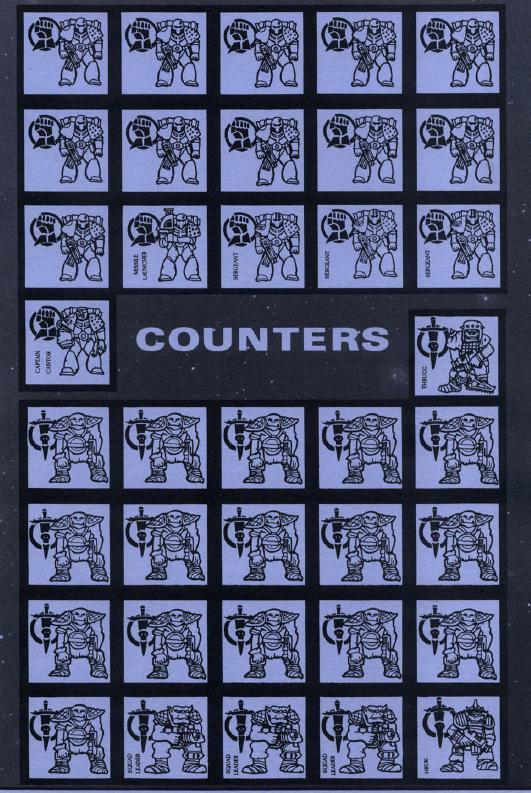Kid_Kyoto
Serf
People here seemed to like my last Retro Review so here's the next one, the big blue book itself, Rogue Trader!
(originally posted here: http://www.dakkadakka.com/dakkaforum/po ... 89919.page)
The year was 1987, when D&D still ruled the card tables in basements across this great land of ours, when these ads started popping up in Dragon Magazine (RIP).

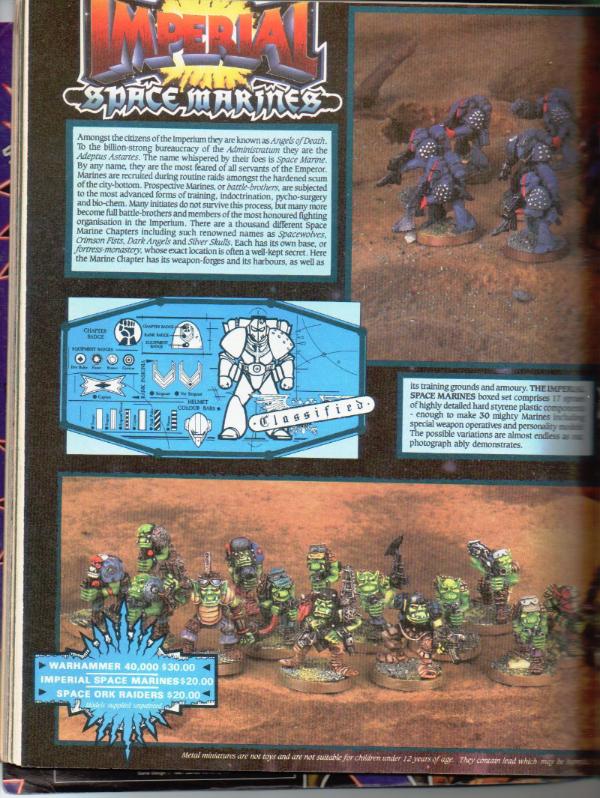
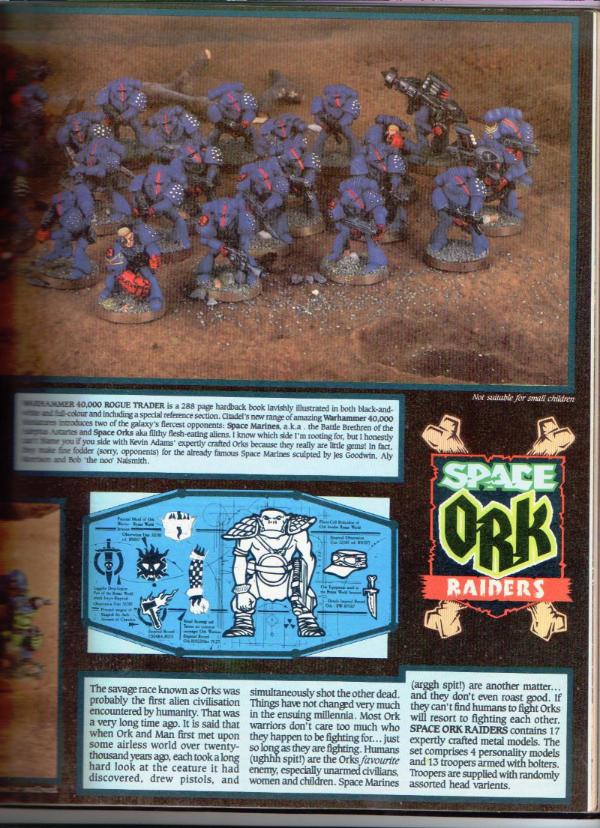
As Malfred once said, could it be any more black, no, it could not.
The ads were filled with these hunch-backed beetle-armored warriors fighting Space Elfs and Space Orks and it seemed fun and full of action. The only problem, the rule book cost $50.
So I passed on it.
It wouldn't be till '93 when a friend showed me the Realms of Chaos books and another showed up with his collection of all 6 Epic armies that I started getting into GW. I finally picked up Rogue Trader at a discount just as 2nd edition was coming out and I've treasured my copy ever since.
I should point out this is not REALLY the beginning for 40k, there were Citadel Journal and WD articles before 40k appeared on how to integrate sci-fi into Warhammer fantasy, and it drew on some earlier games like GW's Judge Dredd RPG, Space Farers and Laserburn.
Unfortunately I don't have access to any of those so if a friendly Dakkite could contribute a Retro Review of some of those materials I think we'd all be grateful.
But enough of that, let's look at Rogue Trader!
Let's start with the cover, and what a cover it is.

Covered in action and details and with the apparent heroes (those hunch-backed beetle-armored fellows from the Dragon Magazine ads) being cut down by enemy fire. It was a daring departure from the look and feel of any other science fiction game out there. Not only was it set far beyond any 'future' I'd ever seen before but it combined elements of medieval fantasy, 'dirty futures' like in Aliens and Lovecraftian horror. Best of all there was not a single bit of spandex to be seen.
And that's just the cover!
Wait till you see page 1!

From the first page 40k sets a tone of despair and darkness no other science fiction game had. This introduction is still used in most books but with an added paragraph about how cool Space Marines are omitting those final words 'But the universe is a big place and, whatever happens, you will not be missed…"
I prefer the original version. I was annoyed when, towards the end of 1st Edition and then from 2nd Edition on GW added the idea of 'special characters' who survive every battle and bestride the galaxy like giants. Yeah sure I understand the idea of reoccurring heroes and villains from a marketing perspective but it makes 40k a lot like other games, we've lost that feeling of 'you will not be missed' and I think it hurts the game.
The design also deserves a lot of praise. At a time when the market leader TSR did not put any color inside the books and art was something separate from the text, GW really set a new standard with Rogue Trader. There's color pages throughout with art and minis. Even the charts are done in universe fashion with nihalistic thoughts for the day like "Death is the only answer' and the art is integrated with the text rather than peppered in randomly. The 1-2 paragraph fluff pieces are also there to set the tone even when the book is covering dry topics like turning radiuses for tanks. This is just a handsome book.

The next few pages establish the basic rules. The initial vision of 40k is muddled to say the least. It's meant to be played with a Game Master or Referee who sets up a scenario and then 2 or more players who bring forces to fight it. Point values are almost an afterthought, instead things are balanced D&D style by random charts (lots of random charts). Rather than try to create balanced forces GW instead gave everyone an even chance figuring things would equal out over time.
But even with that vastly different idea on how to play, even almost 25 years later some mechanics are remarkably the same as now.

Sure some things have been simplified. Since 3rd edition all models have the same move, since 2nd edition all the psychological stats Intelligence, Cool and Will Power have all been combined into Leadership and, as 40k became more of a war game Saves were added as a stat but all in all a player today can recognize the stat line.
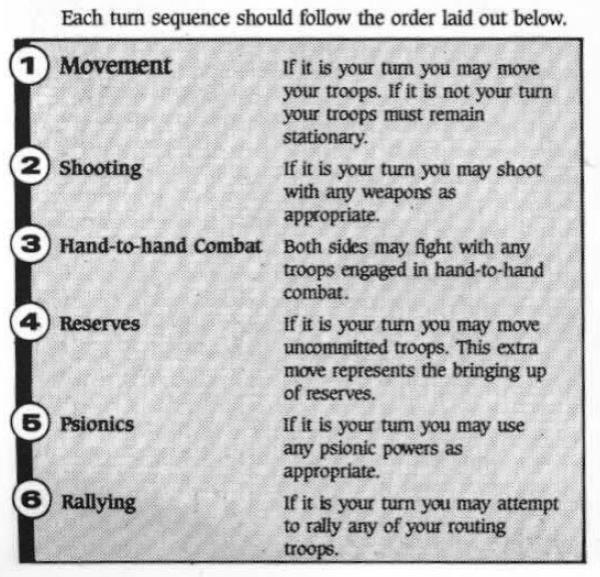
Even the turn is more or less the same, we lost the psychic phase but then got it back. And the basic "I go you go' mechanics are still there for better or for worse.

The rules are a lot more complicated than anything that has come before or since, a holdover from the days of realistic war games (because nothing says realism like Space Marines fighting Orks in the Methane Swamps of Rynn's World) and chart-heavy games of the 70s and 80s.

Of course it's even funnier since many of the complex rules are not realistic, they ignore things like the fact a tank can wheel in place by moving its treads in different directions.

The vehicle damage chart is more complex than the one we have now but better than the 2nd edition (and late 1st edition) days when every vehicle had its own chart.

There's also not much restraint here. In one section they want to cover everything from tanks to bikes, to aircraft to robots. This is an ambitious rule set.

Psychic powers are the next section. In keeping with 40k RPG roots they come in 4 levels and required spending (and tracking) each model's psi points. But again, GW's superior graphic design shines through with Munch-esque images next to each one.

Another 40k staple is mutants, even though GW cut them from 40k after 3rd edition they're still very much a part of the game. As usual the art is both evocative and funny. Making this book must have been a hoot.

In this version (again keeping with the RPG-influenced design) mutations are determined by a random table, some are good, some are bad, others don't do much. Later this table would become a d1000 table in the Realms of Chaos books.

And just to clear something up, black skin was named as a mutation but as the text makes clear they mean ink-black skin, not African.

Finally the rules end with a point system. While points are central to modern 40k they were almost an after-thought in Rogue Trader. And the formula is just bizarre. You modify the stats and come up with a cost, then multiply it by a different number depending on how high it is.

Then add points for weapons and equipment.

That's about it for the rules. Although we can see the basics of the game engine here the simple fact is these rules really didn't work and didn't last too long. By the time the first supplement book (Chapter Approved) came out GW was already throwing out these point rules and moving to army lists. Within a few years they would replace the close assault and vehicle rules as well. And Space Marines would get a few extra rules because, y'know, Space Marines.
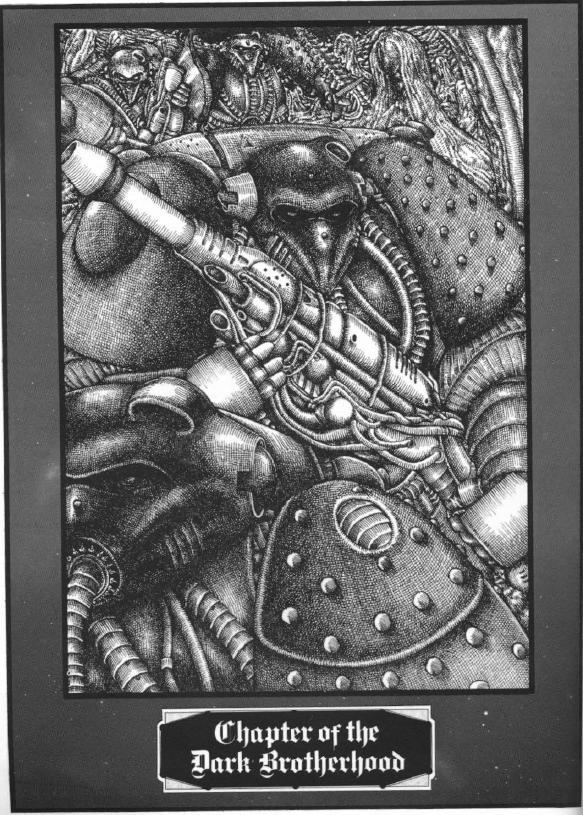
But hey, who plays 40k for the well-written rules anyway?
Join us again for Part II when we look at the early fluff of the 40k universe!
(originally posted here: http://www.dakkadakka.com/dakkaforum/po ... 89919.page)
The year was 1987, when D&D still ruled the card tables in basements across this great land of ours, when these ads started popping up in Dragon Magazine (RIP).



As Malfred once said, could it be any more black, no, it could not.
The ads were filled with these hunch-backed beetle-armored warriors fighting Space Elfs and Space Orks and it seemed fun and full of action. The only problem, the rule book cost $50.
So I passed on it.
It wouldn't be till '93 when a friend showed me the Realms of Chaos books and another showed up with his collection of all 6 Epic armies that I started getting into GW. I finally picked up Rogue Trader at a discount just as 2nd edition was coming out and I've treasured my copy ever since.
I should point out this is not REALLY the beginning for 40k, there were Citadel Journal and WD articles before 40k appeared on how to integrate sci-fi into Warhammer fantasy, and it drew on some earlier games like GW's Judge Dredd RPG, Space Farers and Laserburn.
Unfortunately I don't have access to any of those so if a friendly Dakkite could contribute a Retro Review of some of those materials I think we'd all be grateful.
But enough of that, let's look at Rogue Trader!
Let's start with the cover, and what a cover it is.

Covered in action and details and with the apparent heroes (those hunch-backed beetle-armored fellows from the Dragon Magazine ads) being cut down by enemy fire. It was a daring departure from the look and feel of any other science fiction game out there. Not only was it set far beyond any 'future' I'd ever seen before but it combined elements of medieval fantasy, 'dirty futures' like in Aliens and Lovecraftian horror. Best of all there was not a single bit of spandex to be seen.
And that's just the cover!
Wait till you see page 1!

From the first page 40k sets a tone of despair and darkness no other science fiction game had. This introduction is still used in most books but with an added paragraph about how cool Space Marines are omitting those final words 'But the universe is a big place and, whatever happens, you will not be missed…"
I prefer the original version. I was annoyed when, towards the end of 1st Edition and then from 2nd Edition on GW added the idea of 'special characters' who survive every battle and bestride the galaxy like giants. Yeah sure I understand the idea of reoccurring heroes and villains from a marketing perspective but it makes 40k a lot like other games, we've lost that feeling of 'you will not be missed' and I think it hurts the game.
The design also deserves a lot of praise. At a time when the market leader TSR did not put any color inside the books and art was something separate from the text, GW really set a new standard with Rogue Trader. There's color pages throughout with art and minis. Even the charts are done in universe fashion with nihalistic thoughts for the day like "Death is the only answer' and the art is integrated with the text rather than peppered in randomly. The 1-2 paragraph fluff pieces are also there to set the tone even when the book is covering dry topics like turning radiuses for tanks. This is just a handsome book.

The next few pages establish the basic rules. The initial vision of 40k is muddled to say the least. It's meant to be played with a Game Master or Referee who sets up a scenario and then 2 or more players who bring forces to fight it. Point values are almost an afterthought, instead things are balanced D&D style by random charts (lots of random charts). Rather than try to create balanced forces GW instead gave everyone an even chance figuring things would equal out over time.
But even with that vastly different idea on how to play, even almost 25 years later some mechanics are remarkably the same as now.

Sure some things have been simplified. Since 3rd edition all models have the same move, since 2nd edition all the psychological stats Intelligence, Cool and Will Power have all been combined into Leadership and, as 40k became more of a war game Saves were added as a stat but all in all a player today can recognize the stat line.

Even the turn is more or less the same, we lost the psychic phase but then got it back. And the basic "I go you go' mechanics are still there for better or for worse.

The rules are a lot more complicated than anything that has come before or since, a holdover from the days of realistic war games (because nothing says realism like Space Marines fighting Orks in the Methane Swamps of Rynn's World) and chart-heavy games of the 70s and 80s.

Of course it's even funnier since many of the complex rules are not realistic, they ignore things like the fact a tank can wheel in place by moving its treads in different directions.

The vehicle damage chart is more complex than the one we have now but better than the 2nd edition (and late 1st edition) days when every vehicle had its own chart.

There's also not much restraint here. In one section they want to cover everything from tanks to bikes, to aircraft to robots. This is an ambitious rule set.

Psychic powers are the next section. In keeping with 40k RPG roots they come in 4 levels and required spending (and tracking) each model's psi points. But again, GW's superior graphic design shines through with Munch-esque images next to each one.

Another 40k staple is mutants, even though GW cut them from 40k after 3rd edition they're still very much a part of the game. As usual the art is both evocative and funny. Making this book must have been a hoot.

In this version (again keeping with the RPG-influenced design) mutations are determined by a random table, some are good, some are bad, others don't do much. Later this table would become a d1000 table in the Realms of Chaos books.

And just to clear something up, black skin was named as a mutation but as the text makes clear they mean ink-black skin, not African.

Finally the rules end with a point system. While points are central to modern 40k they were almost an after-thought in Rogue Trader. And the formula is just bizarre. You modify the stats and come up with a cost, then multiply it by a different number depending on how high it is.

Then add points for weapons and equipment.

That's about it for the rules. Although we can see the basics of the game engine here the simple fact is these rules really didn't work and didn't last too long. By the time the first supplement book (Chapter Approved) came out GW was already throwing out these point rules and moving to army lists. Within a few years they would replace the close assault and vehicle rules as well. And Space Marines would get a few extra rules because, y'know, Space Marines.

But hey, who plays 40k for the well-written rules anyway?
Join us again for Part II when we look at the early fluff of the 40k universe!



